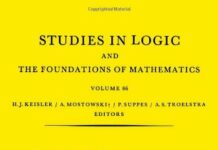
Ebook Info
- Published: 2014
- Number of pages:
- Format: PDF
- File Size: 10.38 MB
- Authors: Kazimierz Kuratowski
Description
The English edition does not differ essentially from the Polish one. Among the more important supplements I should mention § 6.5 containing elementary information on the notation of mathematical logic. To this supplement I was inclined by the experience of many years. For many students (not for all, perhaps) the notation of definitions of certain notions by means of the logical symbols makes it easier to understand these notions (e.g. the notions of uniform continuity or uniform convergence). Besides that, this supplement is included in the book in such a manner that it can be omitted in reading the whole book. Among other changes introduced in the English text, I should mention the addition of a number of exercises and problems; in the second English edition, many of them have been collected in the Supplement. I am glad also to mention the simplification of certain proofs, and finally the removal of mistakes which were found in the primary text
User’s Reviews
Reviews from Amazon users which were colected at the time this book was published on the website:
⭐Why did “calculus” ever need to be “reformed” ? I refer to the colloquium: Calculus For A New Century (Mathematical Association Of America, 1987). There are many excellent (pre-reform) calculus textbooks, among them: Courant, Artin, Spivak, Apostol, Hille, Lax, Moise and Kuratowski ! Certain it is that I’ve forgotten to name a few, certain too that there remains a few which I have yet to peruse. There is, and always has been, an abundance of excellent texts from which to learn calculus. Where does Kuratowski fit ?Fewer applications than some (Courant or Lax), more theoretical than others (Artin or Moise). Kuratowski reminds me of the beautiful (post-reform !) text by Hijab: Introduction To Calculus and Classical Analysis (1997, first edition) !My suggestion: study the 1957 calculus notes of Emil Artin. Then, proceed to Kuratowski. Artin plus Kuratowski comprise a total pagination of 458 (126 plus 332, respectively). I’ve reviewed the notes of Artin’s course elsewhere.Content of Kuratowski’s introduction:(1) Eleven chapters, beginning with sequences and series (eighty pages): Induction, Bolzano-Weierstrass, arithmetic and geometric means, absolute convergence…to name a few of the topics.(2) Functions and limits (sixty pages): monotone, inverse, continuity, uniform convergence. An interlude on Logicawaits (pages 129-136)…. to name but a few topics.(3) Derivatives (sixty pages): elementary functions, Rolle Theorem, power series, differentials…to name a few topics.(4) Integrals (one hundred pages): indefinite and definite integrals, elliptic integrals, area, arc-length, curvature, Wallis and Stirling, Riemann and Darboux, improper integrals and their connection to infinite series.(5) Each chapter has its own exercise/problem set, accompanied by hints to their solution ! For example: “Prove that every function is a sum of an even function and an odd function.” (page 102) and “Characterize the Lipschitz condition geometrically.” (page 117).(6) Supplementary exercises conclude the text (seventeen pages). An example: “Give a geometrical interpretation of the Euler constant.” As with his text, Introduction To Set Theory And Topology, the writing is crisp and much of this material is off-the-beaten-path. For instance, glance at: Limit and number ‘e’ (page 95) or deducing Wallis’ formula (page 261).(7) As my preference, nothing surpasses Apostol’s introduction (Apostol begins with integrals). However, Kuratowski(beginning, as he does, with sequences and series) scores high points. As with any textbook, I urge the reader to glance at problems first. Yes, read the problems first ! Then, return to the body of the text. Keep those exercises in mind while studying the text. Another fine introductory text: Mathematics Of Physics And Modern Engineering, by Sokolnikoff and Redheffer, begins with sequences and series (chapter one). Sound pedagogy ! Kuratowski will amplify their discussion.(8) In conclusion: learning calculus, whether it be Apostol, Artin, Courant, Hille, Kuratowski, Lax, Moise, or Spivak (alphabetically listed), can be–and is–exciting and rewarding ! Whether mathematics or physics student, Kuratowski opens doors. Compare and contrast with Hijab’s fine, but terse, introduction !Study one, or study them all (as did I ).
⭐No idea how good the book is, but if you type kuratowski calculus into Google, you will find a link to archive.org where you can download it for free.
⭐Not found.
⭐Not found.
Keywords
Free Download Introduction to Calculus (ISSN) in PDF format
Introduction to Calculus (ISSN) PDF Free Download
Download Introduction to Calculus (ISSN) 2014 PDF Free
Introduction to Calculus (ISSN) 2014 PDF Free Download
Download Introduction to Calculus (ISSN) PDF
Free Download Ebook Introduction to Calculus (ISSN)

